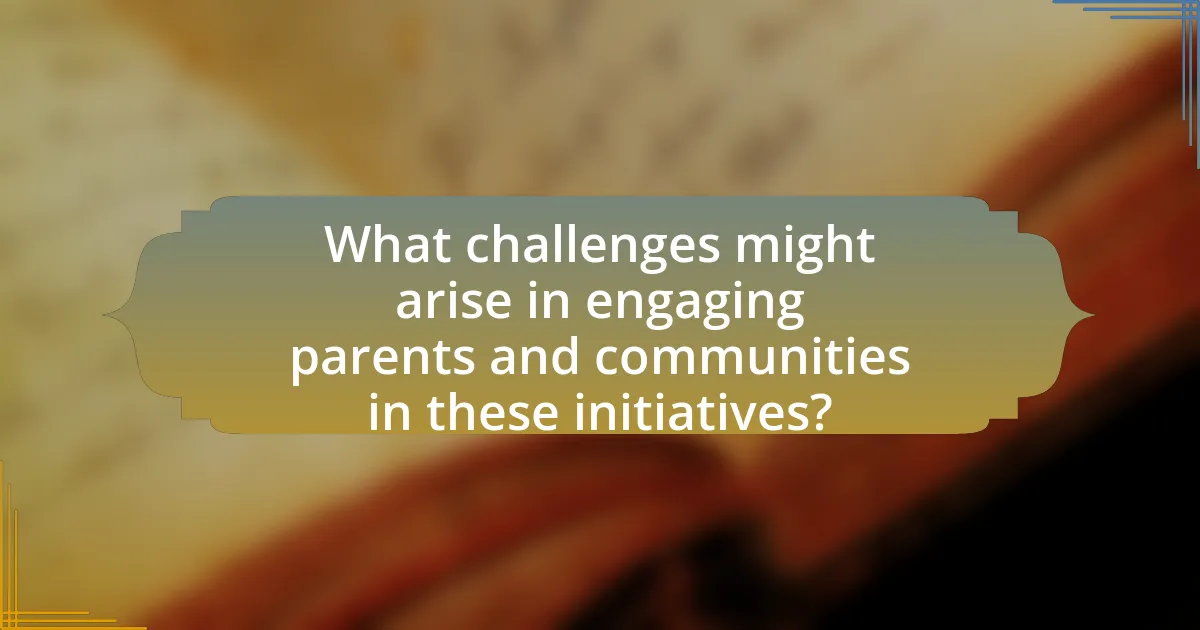Engaging parents and communities in racial justice curriculum initiatives involves their active participation in the development, implementation, and evaluation of educational programs aimed at promoting racial equity. This engagement enhances student outcomes by incorporating diverse perspectives and fostering collaboration between schools and families. Key components of successful engagement strategies include clear communication, active participation, and building trust among stakeholders. The article outlines the roles of parents and communities, effective methods for fostering collaboration, and best practices for integrating racial justice into curricula, while also addressing potential challenges and barriers to engagement.

What does engaging parents and communities in racial justice curriculum initiatives entail?
Engaging parents and communities in racial justice curriculum initiatives entails actively involving these stakeholders in the development, implementation, and evaluation of educational programs focused on racial equity. This engagement includes facilitating open dialogues, gathering input on curriculum content, and fostering partnerships that reflect the diverse perspectives and experiences of the community. Research indicates that when parents and community members participate in educational initiatives, student outcomes improve, as seen in studies like the one conducted by the Harvard Family Research Project, which highlights the positive correlation between family engagement and student achievement.
Why is parental and community engagement crucial in racial justice education?
Parental and community engagement is crucial in racial justice education because it fosters a collaborative environment that enhances the learning experience and promotes social equity. Engaged parents and community members contribute diverse perspectives and resources, which enrich the curriculum and ensure that it reflects the realities and needs of all students. Research indicates that schools with strong community ties see improved student outcomes, as evidenced by a study from the Harvard Family Research Project, which found that students whose parents are involved in their education are more likely to achieve higher grades and have better attendance. This engagement also empowers families to advocate for equitable policies and practices, creating a more inclusive educational landscape.
What roles do parents play in shaping racial justice curriculum initiatives?
Parents play a crucial role in shaping racial justice curriculum initiatives by advocating for inclusive educational content and participating in decision-making processes. Their involvement ensures that the curriculum reflects diverse perspectives and addresses systemic inequalities. Research indicates that when parents engage with schools, they can influence curriculum development, as seen in initiatives like the “Parents for Racial Justice” movement, which emphasizes the importance of parental input in educational reform. This active participation not only empowers parents but also fosters a collaborative environment that prioritizes equity and social justice in education.
How can communities influence the effectiveness of these initiatives?
Communities can influence the effectiveness of racial justice curriculum initiatives by actively participating in the development and implementation processes. When community members, including parents and local organizations, engage in discussions and provide feedback, they ensure that the curriculum reflects the diverse perspectives and needs of the community. Research shows that initiatives with strong community involvement are more likely to succeed; for instance, a study by the National Education Association found that schools with engaged communities saw a 20% increase in student achievement. This active participation fosters a sense of ownership and accountability, leading to more relevant and impactful educational outcomes.
What are the key components of successful engagement strategies?
Successful engagement strategies include clear communication, active participation, and building trust among stakeholders. Clear communication ensures that all parties understand the goals and processes involved, which is essential for fostering collaboration. Active participation encourages stakeholders, such as parents and community members, to contribute their perspectives and insights, enhancing the relevance and effectiveness of the initiatives. Building trust is crucial as it creates a safe environment for open dialogue and collaboration, leading to stronger relationships and commitment to the initiatives. Research indicates that these components significantly improve the likelihood of successful outcomes in community engagement efforts, particularly in sensitive areas like racial justice education.
What methods can be used to foster collaboration between schools and families?
To foster collaboration between schools and families, schools can implement regular communication strategies, such as newsletters, parent-teacher conferences, and digital platforms for updates. These methods ensure that families are informed about school activities and their children’s progress, which enhances engagement. Research indicates that effective communication increases parental involvement, leading to improved student outcomes (Epstein, 2018). Additionally, schools can organize workshops and community events that invite families to participate in the educational process, creating a shared responsibility for student success. Studies show that when families are actively involved, students demonstrate higher academic achievement and better social skills (Henderson & Mapp, 2002).
How can schools effectively communicate the importance of racial justice education to parents?
Schools can effectively communicate the importance of racial justice education to parents by organizing informational workshops and providing clear, accessible resources that outline the curriculum’s objectives and benefits. These workshops can include expert speakers who discuss the historical context and current relevance of racial justice, thereby helping parents understand its significance in fostering an inclusive environment. Research indicates that parental involvement in educational initiatives enhances student outcomes; for instance, a study by the Harvard Family Research Project found that engaged parents contribute to improved academic performance and social skills in children. By actively involving parents in discussions and decision-making processes regarding racial justice education, schools can build trust and encourage a collaborative approach to addressing these critical issues.

How can schools implement racial justice curriculum initiatives effectively?
Schools can implement racial justice curriculum initiatives effectively by integrating community input and fostering collaboration with parents. Engaging parents and community members in the development process ensures that the curriculum reflects diverse perspectives and addresses local issues. Research indicates that when schools involve families in educational initiatives, student outcomes improve; for instance, a study by the Harvard Family Research Project found that family engagement positively impacts student achievement and school climate. Additionally, schools should provide professional development for educators on racial justice topics, equipping them with the necessary tools to teach these subjects effectively. By creating partnerships with local organizations focused on racial equity, schools can enhance resources and support for their initiatives, further solidifying community involvement and commitment to racial justice education.
What are the best practices for integrating racial justice into existing curricula?
The best practices for integrating racial justice into existing curricula include incorporating diverse perspectives, fostering critical discussions, and engaging community stakeholders. Educators should ensure that the curriculum reflects a variety of cultural narratives and historical contexts, which enhances students’ understanding of systemic inequalities. For instance, including literature from authors of diverse backgrounds can provide insights into different experiences and viewpoints.
Additionally, facilitating open dialogues about race and justice encourages students to critically analyze societal structures and their implications. Research indicates that when students engage in discussions about racial issues, they develop greater empathy and awareness (Gorski, 2019, “Rethinking Multicultural Education”).
Finally, involving parents and community members in curriculum development can create a more inclusive educational environment. Collaborating with local organizations that focus on racial justice can provide resources and support, ensuring that the curriculum is relevant and reflective of the community’s needs. This approach not only enriches the educational experience but also strengthens community ties.
How can educators ensure that the curriculum is inclusive and representative?
Educators can ensure that the curriculum is inclusive and representative by integrating diverse perspectives and materials that reflect the backgrounds and experiences of all students. This can be achieved through the selection of texts, resources, and examples that encompass various cultures, histories, and viewpoints, thereby fostering an environment where every student feels valued and understood. Research indicates that inclusive curricula improve student engagement and academic performance, as evidenced by a study from the National Education Association, which found that students exposed to diverse content demonstrate higher levels of critical thinking and empathy. Additionally, involving parents and community members in the curriculum development process can provide valuable insights and ensure that the educational content resonates with the community’s values and experiences.
What resources are available to support the development of racial justice curricula?
Resources available to support the development of racial justice curricula include educational organizations, online platforms, and community-based initiatives. For instance, the Zinn Education Project provides a wealth of teaching materials focused on social justice and racial equity, while Teaching Tolerance offers resources aimed at fostering inclusive classrooms. Additionally, the National Museum of African American History and Culture provides educational resources that highlight African American history and culture, which can be integrated into curricula. These resources are designed to equip educators with the necessary tools to create effective racial justice curricula that engage parents and communities.
How can schools measure the impact of their racial justice initiatives?
Schools can measure the impact of their racial justice initiatives through quantitative and qualitative assessments. Quantitative methods include analyzing changes in student demographics, disciplinary actions, and academic performance metrics before and after the implementation of initiatives. For instance, a study by the National Education Association found that schools implementing restorative justice practices saw a 50% reduction in suspensions, indicating a positive impact on school climate. Qualitative assessments involve gathering feedback from students, parents, and community members through surveys and focus groups, which can provide insights into perceptions of inclusivity and equity. This combination of data allows schools to evaluate the effectiveness of their initiatives comprehensively.
What metrics can be used to assess community and parental involvement?
Metrics to assess community and parental involvement include participation rates in school events, surveys measuring satisfaction and engagement levels, and the frequency of communication between schools and families. Participation rates can be quantified by tracking attendance at meetings, workshops, and volunteer opportunities, providing a clear indicator of involvement. Surveys can gather qualitative and quantitative data on parental perceptions and experiences, revealing insights into their engagement. Additionally, analyzing communication logs, such as newsletters and emails, can help assess the effectiveness and frequency of outreach efforts. These metrics collectively offer a comprehensive view of community and parental involvement in educational initiatives.
How can feedback from parents and communities be incorporated into curriculum improvements?
Feedback from parents and communities can be incorporated into curriculum improvements through structured surveys, focus groups, and community forums that actively solicit input on educational content and teaching methods. These mechanisms allow educators to gather diverse perspectives, ensuring that the curriculum reflects the values and needs of the community. For instance, a study by the National Education Association found that schools that engage parents in curriculum discussions see a 20% increase in student performance, demonstrating the effectiveness of community involvement in educational strategies.

What challenges might arise in engaging parents and communities in these initiatives?
Engaging parents and communities in racial justice curriculum initiatives may face several challenges, including differing perspectives on racial issues, lack of awareness or understanding of the curriculum, and potential resistance to change. These challenges arise because parents and community members may hold varying beliefs about race and education, which can lead to conflicts in priorities and expectations. Additionally, many parents may not be familiar with the concepts of racial justice, making it difficult for them to support or engage with the initiatives effectively. Resistance can also stem from fears of controversial topics being introduced into the curriculum, leading to pushback against the initiatives. Research indicates that effective communication and education about the goals and benefits of these initiatives are crucial for overcoming these barriers and fostering collaboration among stakeholders.
What barriers do schools face in fostering engagement with parents and communities?
Schools face several barriers in fostering engagement with parents and communities, including communication gaps, cultural differences, and resource limitations. Communication gaps often arise from a lack of effective channels to reach parents, leading to misunderstandings about school initiatives. Cultural differences can create challenges in connecting with diverse communities, as schools may not fully understand or respect the values and practices of different cultural groups. Resource limitations, such as insufficient funding or staff, hinder schools’ ability to organize events or programs that promote parental involvement. According to a study by the National Education Association, schools with strong family engagement practices see improved student outcomes, highlighting the importance of overcoming these barriers for effective collaboration.
How can schools address resistance or skepticism from parents regarding racial justice education?
Schools can address resistance or skepticism from parents regarding racial justice education by implementing transparent communication strategies and providing educational resources. Engaging parents through informational sessions that explain the curriculum’s objectives and benefits fosters understanding and trust. Research indicates that when schools involve parents in discussions about racial justice, such as through workshops or community forums, it can reduce misconceptions and build support. For instance, a study by the National Education Association found that inclusive dialogue about racial issues leads to increased parental engagement and acceptance of educational initiatives.
What strategies can be employed to overcome logistical challenges in engagement?
To overcome logistical challenges in engagement, organizations can implement structured communication plans and utilize technology for coordination. Structured communication ensures that all stakeholders are informed and aligned, reducing misunderstandings and enhancing participation. For instance, using platforms like Zoom or Google Meet facilitates virtual meetings, making it easier for parents and community members to engage regardless of location. Additionally, scheduling events at convenient times and providing multiple participation options, such as in-person and online, can significantly increase attendance and involvement. Research indicates that effective communication and flexible engagement strategies lead to higher participation rates in community initiatives, as seen in studies conducted by the National Parent Teacher Association, which highlight the importance of accessibility in fostering community involvement.
How can schools build sustainable partnerships with parents and communities?
Schools can build sustainable partnerships with parents and communities by actively involving them in decision-making processes and curriculum development. Engaging parents through regular communication, workshops, and collaborative events fosters a sense of ownership and investment in the educational environment. Research indicates that schools with strong family and community engagement see improved student outcomes, as highlighted in the “Dual Capacity-Building Framework for Family-School Partnerships” by the U.S. Department of Education, which emphasizes the importance of shared responsibility and mutual respect. By creating inclusive platforms for dialogue and feedback, schools can ensure that diverse perspectives are integrated into racial justice curriculum initiatives, thereby strengthening community ties and enhancing educational relevance.
What are effective ways to maintain ongoing communication and collaboration?
Effective ways to maintain ongoing communication and collaboration include establishing regular check-ins, utilizing digital communication tools, and fostering an inclusive environment for feedback. Regular check-ins, such as weekly meetings or monthly updates, ensure that all stakeholders are informed and engaged in the process. Digital communication tools like emails, messaging apps, and collaborative platforms facilitate real-time interaction and information sharing, making it easier to coordinate efforts. Additionally, creating an inclusive environment encourages parents and community members to voice their opinions and contribute ideas, which strengthens collaboration and builds trust. Research indicates that consistent communication and active participation lead to more successful educational initiatives, particularly in community-focused projects.
How can schools celebrate successes and share progress with stakeholders?
Schools can celebrate successes and share progress with stakeholders by organizing community events, utilizing digital platforms, and distributing newsletters. Community events, such as open houses or award ceremonies, allow schools to showcase student achievements and foster relationships with parents and community members. Digital platforms, including social media and school websites, enable real-time updates on progress and initiatives, reaching a broader audience. Additionally, newsletters can provide detailed reports on curriculum advancements and student successes, ensuring stakeholders are informed and engaged. These methods not only highlight accomplishments but also strengthen community ties and support for ongoing educational initiatives.
What practical steps can schools take to enhance engagement in racial justice curriculum initiatives?
Schools can enhance engagement in racial justice curriculum initiatives by actively involving parents and community members in the development and implementation of these programs. This can be achieved through organizing workshops and forums that invite input from families and local organizations, ensuring that diverse perspectives are represented. Research indicates that when schools collaborate with families, student outcomes improve; for instance, a study by the Harvard Family Research Project found that family engagement in education leads to higher academic achievement and better social skills. Additionally, schools can create partnerships with local advocacy groups to provide resources and training for educators, fostering a more inclusive curriculum that reflects the community’s values and experiences.


